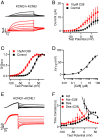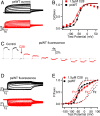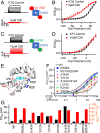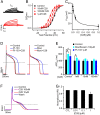Modulating the voltage sensor of a cardiac potassium channel shows antiarrhythmic effects
- PMID: 33990467
- PMCID: PMC8157969
- DOI: 10.1073/pnas.2024215118
Modulating the voltage sensor of a cardiac potassium channel shows antiarrhythmic effects
Abstract
Cardiac arrhythmias are the most common cause of sudden cardiac death worldwide. Lengthening the ventricular action potential duration (APD), either congenitally or via pathologic or pharmacologic means, predisposes to a life-threatening ventricular arrhythmia, Torsade de Pointes. IKs (KCNQ1+KCNE1), a slowly activating K+ current, plays a role in action potential repolarization. In this study, we screened a chemical library in silico by docking compounds to the voltage-sensing domain (VSD) of the IKs channel. Here, we show that C28 specifically shifted IKs VSD activation in ventricle to more negative voltages and reversed the drug-induced lengthening of APD. At the same dosage, C28 did not cause significant changes of the normal APD in either ventricle or atrium. This study provides evidence in support of a computational prediction of IKs VSD activation as a potential therapeutic approach for all forms of APD prolongation. This outcome could expand the therapeutic efficacy of a myriad of currently approved drugs that may trigger arrhythmias.
Keywords: C28; IKs; KCNQ1; antiarrhythmia; voltage sensor domain.
Conflict of interest statement
Competing interest statement: J.S. and J.C. are cofounders of a startup company VivoCor LLC, which is targeting IKs for the treatment of cardiac arrhythmia.
Figures






Similar articles
-
Adult Ventricular Myocytes Segregate KCNQ1 and KCNE1 to Keep the IKs Amplitude in Check Until When Larger IKs Is Needed.Circ Arrhythm Electrophysiol. 2017 Jun;10(6):e005084. doi: 10.1161/CIRCEP.117.005084. Circ Arrhythm Electrophysiol. 2017. PMID: 28611207 Free PMC article.
-
The electrophysiologic effects of KCNQ1 extend beyond expression of IKs: evidence from genetic and pharmacologic block.Cardiovasc Res. 2024 May 29;120(7):735-744. doi: 10.1093/cvr/cvae042. Cardiovasc Res. 2024. PMID: 38442735 Free PMC article.
-
Modulation of KCNQ1 alternative splicing regulates cardiac IKs and action potential repolarization.Heart Rhythm. 2013 Aug;10(8):1220-8. doi: 10.1016/j.hrthm.2013.04.014. Epub 2013 Apr 19. Heart Rhythm. 2013. PMID: 23608591 Free PMC article.
-
Insights into Cardiac IKs (KCNQ1/KCNE1) Channels Regulation.Int J Mol Sci. 2020 Dec 11;21(24):9440. doi: 10.3390/ijms21249440. Int J Mol Sci. 2020. PMID: 33322401 Free PMC article. Review.
-
Pharmacology of cardiac potassium channels.Cardiovasc Res. 2004 Apr 1;62(1):9-33. doi: 10.1016/j.cardiores.2003.12.026. Cardiovasc Res. 2004. PMID: 15023549 Review.
Cited by
-
Structural mechanisms for the activation of human cardiac KCNQ1 channel by electro-mechanical coupling enhancers.Proc Natl Acad Sci U S A. 2022 Nov 8;119(45):e2207067119. doi: 10.1073/pnas.2207067119. Epub 2022 Nov 3. Proc Natl Acad Sci U S A. 2022. PMID: 36763058 Free PMC article.
-
Ion channel traffic jams: the significance of trafficking deficiency in long QT syndrome.Cell Discov. 2025 Jan 10;11(1):3. doi: 10.1038/s41421-024-00738-0. Cell Discov. 2025. PMID: 39788950 Free PMC article. Review.
-
Targeting ion channels with ultra-large library screening for hit discovery.Front Mol Neurosci. 2024 Jan 5;16:1336004. doi: 10.3389/fnmol.2023.1336004. eCollection 2023. Front Mol Neurosci. 2024. PMID: 38249296 Free PMC article. Review.
-
An allosteric modulator activates BK channels by perturbing coupling between Ca2+ binding and pore opening.Nat Commun. 2022 Nov 9;13(1):6784. doi: 10.1038/s41467-022-34359-6. Nat Commun. 2022. PMID: 36351900 Free PMC article.
-
The fully activated open state of KCNQ1 controls the cardiac "fight-or-flight" response.PNAS Nexus. 2024 Oct 9;3(10):pgae452. doi: 10.1093/pnasnexus/pgae452. eCollection 2024 Oct. PNAS Nexus. 2024. PMID: 39434867 Free PMC article.
References
-
- Keating M. T., Sanguinetti M. C., Molecular and cellular mechanisms of cardiac arrhythmias. Cell 104, 569–580 (2001). - PubMed
-
- Wang H. S., Brown B. S., McKinnon D., Cohen I. S., Molecular basis for differential sensitivity of KCNQ and I(Ks) channels to the cognitive enhancer XE991. Mol. Pharmacol. 57, 1218–1223 (2000). - PubMed
-
- Barhanin J., et al. ., K(V)LQT1 and lsK (minK) proteins associate to form the I(Ks) cardiac potassium current. Nature 384, 78–80 (1996). - PubMed
Publication types
MeSH terms
Substances
Grants and funding
LinkOut - more resources
Full Text Sources
Other Literature Sources

